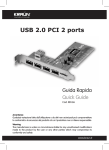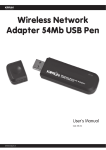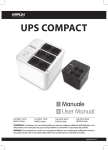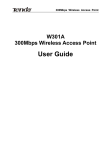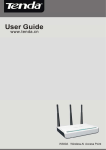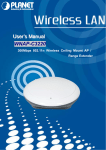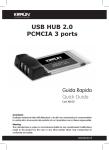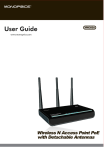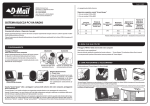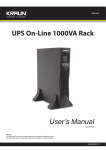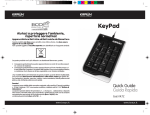Download User's Manual Wireless Access Point Ceiling 300Mbps
Transcript
Manual Wireless Access Point Ceiling 300Mbps User’s Manual Cod. KR.KZ Warning The manufacturer is under no circumstances liable for any unauthorised modifications made to the product by the user or any other parties which may compromise its conformity and safety. www.kraun.it Manual TABLE OF CONTENTS Chapter 1. Product Overview 4 1.1 Product Features 1.2 Package Contents 4 4 Chapter 2. Product Installation 5 2.1 Default Settings 5 Chapter 3. Configuration Guide 6 3.1 Web Login 3.2 Setup Wizard 6 7 Wireless Access Point (AP) Mode 7 Bridge (WDS) Mode 3.3 Running Status 3.4 LAN Settings 9 11 12 Chapter 4. Wireless Settings 13 4.1 Basic Settings 4.1.1 Access Point (AP) Mode 4.1.1.1 Application and Topology Plan 4.1.1.2 Function Explanation 4.1.2 Bridge (WDS) Mode 4.1.2.1 4.1.2.1 Point to Point Bridge 4.1.2.2 P2MP Bridge Mode 4.1.2.3 Wireless Repeater Mode 4.2 Security Settings 4.2.1 AP Security Setting 13 13 13 14 15 15 16 17 18 18 Mixed WEP 18 Setting Explanation 18 WPA- PSK 19 Setting Explanation 19 WPA2-PSK 20 Setting Explanation 20 WPA 21 Setting Explanation 21 WPA2 22 Setting Explanation 22 802.1x Authentication 23 Setting Explanation 4.2.2 WDS Security Setting 4.3 Advanced Settings 23 24 25 Setting Explanation: 4.4 Access Control 25 26 Setting Explanation: 4.5 Connection Status 26 26 Setting Explanation: 26 2 www.kraun.it Manual Chapter 5. System Tools 5.1 5.2 5.3 5.4 27 Password Change Restore to Factory Backup/Restore Time Settings 27 27 28 28 Setting Explanation: 5.5 Reboot System 5.6 Syslog 28 29 29 Chapter 6. Appendix II: WDS Application Instances 3 32 www.kraun.it Manual Chapter 1. Product Overview KR.KZ is a wireless Access Point based on the latest IEEE802.11n standard while at the same time being backwards compatible with IEEE802.11b/g devices. Adopting the advanced “Multiple in and Multiple out” (MIMO) technology, it can provide a maximum of 300Mbps stable transmitting rate for wireless users. With appropriate Power over Ethernet (POE) support, you only need to run one cable to the AP to deliver both data and power. Ceiling mounted design and POE technology make it couldn’t be easier for family, enterprise, and hotel users to extend wireless networks indoors. Unique Watchdog technology makes AP working more stably and wireless network running normally for a long time. Wireless AP and WDS working modes support wireless AP, wireless Repeater, wireless Point-to-Point (P2P) Bridge, and wireless Point-to-Multipoint (P2MP) Bridge functions. Firstly, it can be used as a wireless Hot Spot to enable the accesses of wireless users when in AP mode. Secondly, it can be used as a Bridge to connect two or more wired networks when it is in P2P or P2MP mode. Thirdly, it can also be used as a wireless Repeater to expand your wireless network coverage area. Furthermore, 64/128-bit Wired Equivalent Privacy (WEP), WPA-PSK, WPA2-PSK, WPA&WPA2, 802.1X Authentication, and MAC Address filter are all supported to protect your data and privacy. Gigabit LAN port provides you higher LAN transmission rate. SNMP and Web-based management interface make configuration easier than ever. 1.1 Product Features yy yy yy yy yy yy yy yy yy yy yy yy yy yy yy Complies with the latest 802.11n and 802.11b/g standards Supports AP and WDS working modes Provides 300Mbps receiving and transmitting rate MIMO technology uses signal reflections to increase 8 times transmission distance of 802.11g standard and efficiently reduce “dead spots” One Gigabit Auto-negotiation LAN port supported for LAN connection POE and external power supported SNMP and Web-based management interface 64/128-bit WEP encryption WPA-PSK, WPA2-PSK, WPA&WPA2 encryption methods Auto MDI/ MDIX Wireless VLAN divisible for managing clients conveniently Client’s access limited Watchdog designed to make device run stably Supports auto wireless channel selection Software controls the wireless signal on/ off and remotely controls the wireless coverage area. 1.2 Package Contents Please unpack the package and find the following items: yy One KR.KZ Wireless AP yy One Power Adapter yy Eight Screws yy One User Guide yy One Network Cable yy Four plastic covers If any of listed items are missing or damaged, please contact the Tenda reseller from whom you purchased for replacement immediately. 4 www.kraun.it Manual Chapter 2. Product Installation You are recommended to install the product after configuring the settings of KR.KZ according to the guide in chapter 3. The following steps take AP mode for example. 1. Use the included power adapter to power on the AP. You can also use POE power supply or POE switch to power on the AP. 2. Connect one end of the network cable to the LAN port of KR.KZ, and another end to your Ethernet broadband, switch or PC. 3. Connect wireless adapter to KR.KZ. Please refer to the topology below: 2.1 Default Settings The default mode setting of this device is AP (Access Point): Item Common Default Settings Username Password IP Address Subnet Mask Wireless SSID Wireless Security Security Type Criptazione (Encryption) WPA KEY DHCP Server Default Value admin admin 192.168.0.254 255.255.255.0 KRAUN_the last 6 characters of MAC address (example KRAUN_123456) Enable WPA-PSK/WPA2-PSK tkip+aes KRAUN_KR.KZ Disable 5 www.kraun.it Manual Chapter 3. Configuration Guide 3.1 Web Login Connect to KR.KZ via wired cable and configure 192.168.0.x(x ranges 2-254) as your PC’s IP address, and 255.255.255.0 as subnet mask. (Please refer to the Appendix II for details on TCP/IP setting) Launch Internet Explorer. In the address bar, enter the AP’s default IP address, 192.168.0.254. Press Enter key and the login screen will appear. Enter admin both in the user name and password field. Click OK to enter the welcome page of the device. You can select “Running Status”, ”LAN Settings”, “Wireless Settings”, “SNMP Settings” and “System Tools” on the left menu. Click “Next” to enter the wireless working mode setup page. KR.KZ supports two working modes: wireless AP (AP), Bridge (WDS). Select a working mode to configure the settings. For more details please refer to the following chapters. 6 www.kraun.it Manual 3.2 Setup Wizard Click “Next” in the first page and the next page appears. On this page, you can select wireless AP or Bridge to adapt different wireless access environment. Wireless Access Point (AP) Mode Select “Wireless Access Point (AP)” and then click “Next” to enter the basic settings. Picture 4 Fill in the following items according to the reminder information. 1. SSID: Set the SSID name of the device. 2. Channel: Select the wireless communication channel. The default is channel 6. 7 www.kraun.it Manual After you finish the settings, click “Next” to enter the “Security Settings” page as the picture below: “Security Settings” is used to encrypt the settings for AP and authorize the wireless client to access the AP for security in wireless network. Please refer to chapter 4.1.1.2 for detailed security setting specifications. After finishing the settings, click “Next” to finish settings as the picture below. 8 www.kraun.it Manual Bridge (WDS) Mode Select “Setup Wizard” on the left menu and the working mode selection interface will appear as the picture below. Select Bridge (WDS) and then click “Next”. You will enter the WDS setup page as the picture below. Bridge (WDS) working mode includes: Point to Point Bridge (WDS P2P), Point to Multipoint Bridge (WDS P2MP), Wireless Repeater (Repeater). Users can select the mode according to need. Please refer to Chapter 4.1.2 for detailed introduction. Click “Enable Scan”. AP will scan the available wireless device nearby automatically and display them under the 9 www.kraun.it Manual list (see the picture below). Select the AP which you need to bridge and click “Next” to enter the security setup interface. On the other hand, you can input the MAC address of wireless device which you want to bridge manually and select the corresponding channel. After finish the settings, click “Next” to enter the “Security Setting” option as the picture below. “WDS Security Setting” is used to encrypt the AP and authorize the device to establish bridge. Only when the passwords of the devices in bridge are consistent, the communication can get through normally. 10 www.kraun.it Manual After finishing the settings, click “Next” and “Save” to finish settings. 3.3 Running Status This page shows the wireless AP’s current status, including wireless status, LAN status and system information. yy Wireless Status It shows the current working status, including working mode, wireless network mode, SSID, Channel, Encryption mode, etc. 11 www.kraun.it Manual yy LAN Interface information It shows LAN IP obtain way, MAC address, IP address, subnet mask, etc. yy System information It shows the device’s current software version, hardware version, etc. 3.4 LAN Settings This section mainly deals with LAN’s basic settings. hh Static IP: The default IP address is 192.168.0.254. If necessary, you can configure a new IP address, subnet mask and gateway manually for the device. hh Dynamic IP: Automatically obtain IP address, subnet mask and gateway from DHCP server. (Unless you have got permission to obtain this information from the uplink connected device, otherwise, it is not recommended to select this way). Note: If the LAN IP address is changed, you need use the new IP address to login the wireless AP’s Web interface next time. 12 www.kraun.it Manual Chapter 4. Wireless Settings This chapter introduces you wireless settings in two working modes: Access Point (AP) and Bridge (WDS), including basic settings, security settings, advanced settings, access control, and connection status. 4.1 Basic Settings This period introduces you the basic settings in AP mode and WDS mode. 4.1.1 Access Point (AP) Mode In this mode, the AP will act as a central hub for accesses from wireless to wireless, wireless to wired, wireless to WAN. The most important is to provide a wireless client access such as wireless network adapter access. 4.1.1.1 Application and Topology Plan The AP mode can convert the wired transmission into wireless signals. If you have one wired cable connecting to Internet, and want to access the Internet via wireless signals connecting to your notebook computer, this mode fits perfectly. 13 www.kraun.it Manual 4.1.1.2 Function Explanation The basic setup page in Access Point (AP) working mode is as follows: hh hh hh hh hh hh hh hh hh hh hh hh hh Wireless Signal: Click “Disable” to shut all the wireless feature of this AP; click “Enable” to open the wireless feature. Network Mode: Select one mode from the following. The default is 11b/g/n mode. 11b mode: Allow the wireless client to connect with the device in 11b mode at the maximum speed of 11Mbps. 11g mode: Allow the 11g/11n-compliant client device to connect with the AP at the maximum speed of 54Mbps. 11b/g mode: Allow the 11b/g-compliant client device to connect with the AP with auto-negotiation speed, and 11n wireless client to connect the device with 11g speed. 11b/g/n mode: Allow 11b/g/n-compliant client device to connect with the AP with auto- negotiation speed. The maximum speed is 300Mbps. Main SSID: SSID (Service Set Identifier) is the unique name of the wireless network. It is recommended to modify this name for wireless client to recognize wireless signals. Broadcast SSID: When you select “Disable SSID broadcast”, AP will not broadcast its own SSID number. If there is a wireless connection request, you need to input SSID number manually. BSSID: Basic Service Set Identifier of wireless network. In IEEE802.11, BSSID is the MAC address of wireless access point. WLAN Isolation: The access control feature based on wireless MAC address. When this feature is enabled, each of your wireless clients will be in its own virtual network and will not be able to communicate with each other. This feature is to isolate the communication of wireless clients connected with different AP. Channel: Specify the effective channel (from 1 to 13\Auto) of the wireless network. Extension channel: To increase data throughput of wireless network, the extension channel range is used in 11n mode. Channel Bandwidth: Select the proper channel bandwidth to improve the wireless performance. 20M bandwidth can improve the anti-jamming ability of the wireless device. 40M bandwidth can improve the flux of 11N client. 14 www.kraun.it Manual 4.1.2 Bridge (WDS) Mode Bridge (WDS) mode includes P2P, P2MP, Wireless Repeater. 4.1.2.1 4.1.2.1 Point to Point Bridge P2P bridge mode can connect with two wired network via wireless access points, which communicate by wireless signals and not by cables. This mode can be free from the cable trouble. The P2P topology shows below Modem Ethernet Switch Switch Select P2P Bridge in drop-down list of WDS mode as the picture below: This page includes the AP and WDS parameter setting. AP parameter setting can change SSID and enable/ disable wireless feature. hh AP MAC: Enter the interconnection equipment’s MAC address. hh Channel: Select the channel according to interconnection equipment’s; the devices on the two ends must be at the same channel. hh Open Scan: Click this button, the AP will scan the nearby wireless devices automatically and display the information in the table. Select the device which need to bridge, the AP will add the device’s MAC address automatically and select the corresponding channel. 15 www.kraun.it Manual 4.1.2.2 P2MP Bridge Mode The P2MP Bridge Mode which connects scattered wired network together is more complicated than P2P Bridge mode. P2MP usually transmit wireless signals from one access point, and other access points are in charge of receiving signals so as to share network resource. Support up to 4 remote access point connection. In this mode, wireless clients are not allowed to connect. P2MP Bridge mode can connect multiple wireless access point together without cabling. If “Root AP” is configured as P2MP bridge mode, other (less than 4) remote access points should select P2P bridge modes. The topology shows below: Modem Ethernet Switch Select WDS P2MP mode in the drop-down box of WDS mode as the picture below. hh AP MAC Address: Input the remote AP’s MAC address. (No more than 4) hh Channel: Select the channel which bridge needs to use. (All APs in the bridge must be at the same channel.) hh Enable Scan: Click this button, the AP will scan the nearby wireless devices automatically and display the information in the table. Select the device which need to bridge, the AP will add the device’s MAC address automatically and select the corresponding channel. When multiple devices are added, AP will select the channel of the last added device as the bridge used channel (You can also change the channel according to your need. All the devices must at the same channel, thus the bridge can be established.) 16 www.kraun.it Manual 4.1.2.3 Wireless Repeater Mode Repeater Mode can repeat and amplify wireless signals to extend wireless network coverage. In this mode, wireless clients are allowed to connect. When two LAN’s transmission distance is over the wireless device’s maximum transmission value, or there is much block among devices, you can use the Repeater mode to deal with these problems by adding MAC addresses. The topology shows below: Modem Ethernet Switch Select wireless repeater on the drop-down box of WDS mode and the page will show as below. When the users select “permit wireless client to access”, AP can also be used as “Wireless Access Point” to allow the access of wireless client when it is used as a wireless bridge. The basic settings of wireless repeater are divided into two parts: one part is the basic setting in AP mode (See 4.1.1.2); another part is the basic setting in WDS mode (See 4.1.2.2). 17 www.kraun.it Manual 4.2 Security Settings It is used to configure the AP network’s security setting, including AP security setting and WDS security setting. 4.2.1 AP Security Setting We introduce six common encryption modes to you (support ten encryption modes), including Mixed WEP encryption, WPA-PSK, WPA-Enterprise, WPA2-PSK, WPA2-Enterprise, etc. Mixed WEP WEP (Wired Equivalent Privacy), a basic encryption method, usually encrypts wireless data using a series of digital keys (64 bits or 128 bits in length). By using the same keys on each of your wireless network devices, you can prevent unauthorized wireless devices from monitoring your transmissions or using your wireless resources. WEP is based on RSA algorithm from RC4. It is the original and weak encryption method, so it is recommended not to use this method. Select Mixed WEP to enter the following window: Setting Explanation hh Security Mode: From the drop-down menu select the corresponding security encryption modes. hh WEP Key1~4: Set the WEP key with the format of ASCII and Hex. You can enter ASCII code (5 or 13 ASCII characters. Illegal character as “/” is not allowed.) Or 10/26 hex characters. hh Default Key: Select one key from the four configured keys as the current available one. 18 www.kraun.it Manual WPA- PSK WPA (Wi-Fi Protected Access), a Wi-Fi standard, is a more recent wireless encryption scheme, designed to improve the security features of WEP. Select “WPA-PSK” from the drop-down menu to enter the following window: Setting Explanation hh WPA Algorithms: Provides TKIP [Temporal Key Integrity Protocol] or AES [Advanced Encryption Standard]. The default is TKIP mode. hh Pass Phrase: Enter the encrypted characters with 8-63 ASCII characters. hh Key Renewal Interval: Set the key’s renewal period. 19 www.kraun.it Manual WPA2-PSK WPA2 provides more secure features than WEP and WPA. Select “WPA2-PSK” from the drop-down menu to enter the following window: Setting Explanation hh WPA Algorithms: Provides TKIP [Temporal Key Integrity Protocol] or AES [Advanced Encryption Standard]. The default is TKIP mode. hh Pass Phrase: Enter the encrypted characters with 8-63 ASCII characters. hh Key renewal Interval: Set the key’s renewal period. 20 www.kraun.it Manual WPA This security mode is used when a RADIUS server is connected to the device. Select “WPA” from the drop-down menu to enter the following window: Setting Explanation hh WPA Algorithms: Provides TKIP [Temporal Key Integrity Protocol] or AES [Advanced Encryption Standard]. The default is TKIP mode. hh Pass Phrase: Enter the encrypted characters with 8-63 ASCII characters. hh Key Renewal Interval: Set the key’s renewal period. hh Radius Server: Enter the IP address of the Radius server. hh Radius Server port: Enter the authentication port of the Radius server. The default is 1812. hh Shared Secret: Enter the shared key for authentication server with 8~63 ASCII characters. hh Session Timeout: The authentication interval period between AP and authentication server. The default is 3600s. 21 www.kraun.it Manual WPA2 This security mode is based on Radius authentication server and WPA2 encryption method. WPA2 is used when a RADIUS server is connected to the device. Select “WPA2” from the drop-down menu to enter the following window: Setting Explanation hh WPA Algorithms: Provides TKIP [Temporal Key Integrity Protocol] or AES [Advanced Encryption Standard]. The default is TKIP mode. hh Pass Phrase: Enter the encrypted characters with 8-63 ASCII characters. hh Key Renewal Interval: Set the key’s renewal period. hh Radius Server: Enter the IP address of the Radius server. hh Radius Server Port: Enter the authentication port of the Radius server. The default is 1812. hh Shared Key: Enter the shared key for authentication server with 8~63 ASCII characters. hh Session Timeout: The authentication interval period between AP and authentication server. The default is 3600s. 22 www.kraun.it Manual 802.1x Authentication This security mode is used when a RADIUS server is connected to the device. 802.1x, a kind of Port-based authentication protocol, is an authentication type and strategy for users. The port can be either a physic port or logic port (such as VLAN). For wireless LAN users, a port is just a channel. The final purpose of 802.11x authentication is to check if the port can be used. If the port is authenticated successfully, you can open this port which allows all the messages to pass. If the port isn’t authenticated successfully, you can keep this port “disable” which just allows 802.1x authentication protocol message to pass. Select “802.1x” from the drop-down menu to enter the following window: Setting Explanation hh 802.1x WEP: Click “Enable/Disable” to enable or disable the WEP algorithm. hh Radius Server: Enter the IP address of the Radius server. hh Radius Server Port: Enter the authentication port of the Radius server. The default is 1812. hh Shared Secret: Enter the shared key for authentication server with 8~63 ASCII characters. hh Session Timeout: The authentication interval period between AP and authentication server. The default is 3600s. Note: To improve security level, do not use too easy characters. 23 www.kraun.it Manual 4.2.2 WDS Security Setting WDS Security Setting is to protect the data safety of wireless bridge. The security setup page of Point to Point Bridge and Point to Multipoint Bridge is as the picture below. WDS security setting provides three encryption modes: WEP encryption, TKIP encryption and AES encryption. hh WEP Key: You can set the WEP key in ASCII code or Hexadecimal code. hh Key: You can choose ASCII code (5 or 13 ASCII codes, illegal characters like “/” are forbidden) or Hexadecimal characters (10 or 26 Hexadecimal characters). hh TKIP/ AES Key: TKIP/AES is an encryption mode based on WPA and WPA2. hh Key: Key characters are ASCII codes from 8 to 63. Note: The encryption mode and password of each device in the bridge must be consistent, thus the connection can be established. You are recommended to encrypt the bridge to protect the wireless bridge. The security setup page of wireless repeater is as follows: Security setting of wireless repeater can be divided into AP security setting and WDS security setting. AP security setting focuses on wireless client access, while WDS security setting focuses on wireless bridge connection. AP security setting appears only when wireless client accesses are permitted in wireless repeater mode. Please refer to Chapter 4.2.1 for AP security setup. 24 www.kraun.it Manual 4.3 Advanced Settings This section mainly deals with wireless advanced settings, including Speed, Beacon Interval, Fragment Threshold, etc. Select “Wireless Setting->Advanced Setting” to enter the following screen: Setting Explanation: hh BG Protection Mode: For 11b/g wireless client, it is easier to connect with 11n wireless device. The default is “Auto”. hh Basic Data Rates: In term of different requirements, you can select one of the suitable Basic Data Rates from the drop-down menu. Here, default value is (1-2-5.5-11Mbps…). It is recommended not to modify the default value. hh Beacon Interval: The frequency interval of the beacon, which is a packet broadcast by an AP to synchronize a wireless network. The default value is 100 ms. hh Fragment Threshold: The fragmentation threshold defines the maximum transmission packet size in bytes. The packet will be fragmented if the arrival is bigger than the threshold setting. The default size is 2346 bytes. hh RTS Threshold: RTS stands for “Request to send”. This parameter controls what size data packet the frequency protocol issues to RTS packet. If the device works in SOHO, do not modify the default value. hh TX Power: Set the wireless output power level. The default value is 100. hh WMM Capable: To enhance wireless multimedia transfer performance (0n-line video and voice). If you are not clear about this, enable it. hh APSD Capable: It is used for auto power-saved service. The default is disabled. 25 www.kraun.it Manual 4.4 Access Control To secure your wireless LAN, the wireless access control is actually based on the MAC address management. Select “Wireless Setting->Access Control” to display the following screen: Setting Explanation: hh MAC Address Filter: Enable/disable MAC address filter. Select “Close” to malfunction MAC address; “disable” to prevent the MAC addresses in the list from accessing the wireless network; “Allow” to allow the MAC address in the list to access the wireless network. hh MAC Address Management: Input the MAC address to implement the filter policy. Click “Add” to finish the MAC add operation. hh MAC list: Show the added MAC address. You can add or delete them. Note: This AP can support no more than 32 MAC addresses. 4.5 Connection Status This page shows wireless client’s connection status, including MAC address, Channel bandwidth, etc. Select “Wireless Setting->connection status” to enter the following screen: Setting Explanation: MAC Address: Shows current connecting host’s MAC address. Bandwidth: Shows current connecting host’s (wireless client) bandwidth (20MHz or 40MHz). 26 www.kraun.it Manual Chapter 5. System Tools This section focuses on how to maintain AP, including Restore to Factory Default Setting, Backup/Restore, Firmware Upgrade, Reboot, Password Change, Syslog. 5.1 Password Change This section is to set a new user name and password to better secure your device and network. Click “Apply” to finish changing password. hh User Name: Enter a new user name for the device. hh Old Password: Enter the old password. hh New Password: Enter a new password. hh Re-enter to Confirm: Re-enter to confirm the new password. NOTE: It is highly recommended to change the password to secure your network and the device. 5.2 Restore to Factory This button is to reset all configurations to the default values. It means the device will lose all the settings you have set. Restore: Click this button to restore to default settings. Factory Default Settings: User Name: admin Password: admin IP Address: 192.168.0.254 27 Subnet Mask: 255.255.255.0 www.kraun.it Manual 5.3 Backup/Restore The device provides backup/restore settings, so you need set a directory to keep these settings. Backup: Click this button to back up the device’s configurations. Browse: Click this button to browse the directory where you backup or save the device’s settings. Restore: Click this button to restore the device’s configurations. 5.4 Time Settings This section is to select the time zone for your location. You can select your own time or obtain the standard GMT time from Internet. Setting Explanation: hh Time Zone: Select your time zone from the drop-down menu. hh Customized time: Enter the time you customize. 28 www.kraun.it Manual 5.5 Reboot System This page is used to reboot wireless access point. Rebooting the device makes the settings configured go into effect. Reboot: Click this button to reboot the device. 5.6 Syslog The section is to view the system log. Click the “Refresh” to update the log. Click “Clear” to clear all shown information. If the log is over 150 records, it will clear them automatically. Refresh: Click this button to update the log. Clear: Click this button to clear the current log. 29 www.kraun.it Manual Appendix I: TCP/IP Address Setting (Take WinXP for example) Click the “Start—>Settings—>Control Panel” (Fig- 1): Click “Network and Internet Connections”, the windows as below will appear (Fig- 2): Click the “Network Connections”, as Fig-3: Choose “Local Area Connection”, right-click on the icon, choose the “Properties”, then the “Local Area Connection Properties”windows appear, choose the “Internet Protocol (TCP/IP)” in the “This connection uses the following items”, click the “Properties”. 30 www.kraun.it Manual Choose the “Use the following IP address”, enter the IP address as: 192.168.0.xxx. (xxx ranges 1~253), Subnet mask is: 255.255.255.0(As Showed in Fig- 5) Click “OK” to apply and return to the “Local Area Connection Properties” windows. Continue click “OK” to exit the setting windows. 31 www.kraun.it Manual Chapter 6. Appendix II: WDS Application Instances The configurations of P2P, P2MP and Wireless Repeater in WDS mode are almost the same. The number of devices which need to be configured is different according to different mode. The following steps take P2P for example. If you want to establish P2P transmission between AP1 and AP2, you need to set the parameters as follows. Select “WDS” mode in Setup Guide for AP1 and set the SSID as “AP1” and channel as “13”. The BSSID is 00:b0:c6:05:4e:d0. Click “Next” to enter the WDS Security Setting. Select the encryption mode you need to use. (For example: set the encryption mode as TKIP and enter the encryption key as 12345678.) 32 www.kraun.it Manual Click “Next” and save the settings. Then enter the AP2 settings. Select “WDS” mode for AP2 and set SSID as “AP2”. Select the channel “13” which is the same as AP1. Enter the BSSID: 00:b0:c6:05:4e:d0 of AP1 into the AP MAC blank and record the BSSID 00:b0:c6:05:4e:dd of AP2. (You can also use “Enable scan to add”.) Click “Next” to enter the WDS security setting and select AP1 corresponding encryption mode. Then enter the encryption key. (We select TKIP and encryption key 12345678.) 33 www.kraun.it Manual Click “Next” and save the settings. After you finished AP2 settings, return to AP1 setting. Select “Wireless Settings Basic Setting” in AP. SSID, channel and extension channel can’t be changed. You only need to enter BSSID: 00:b0:c6:05:4e:dd of AP2 in AP MAC address blank an then save it (You can also use “Enable Scan to add”). Now all the settings of WDS have been finished. 34 www.kraun.it Manual 35 www.kraun.it




































